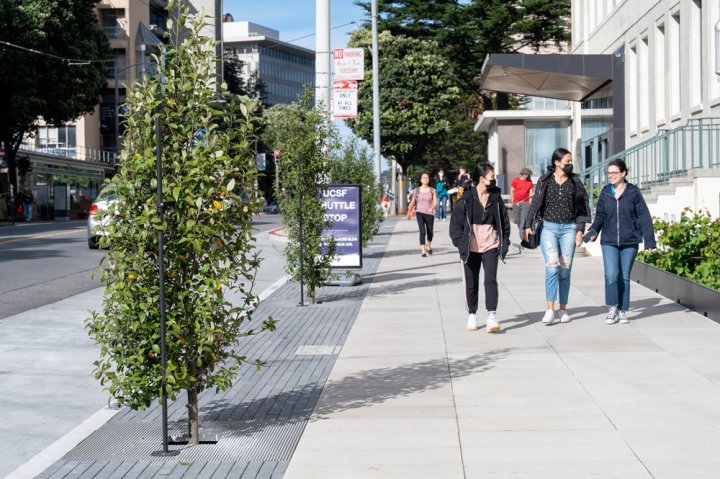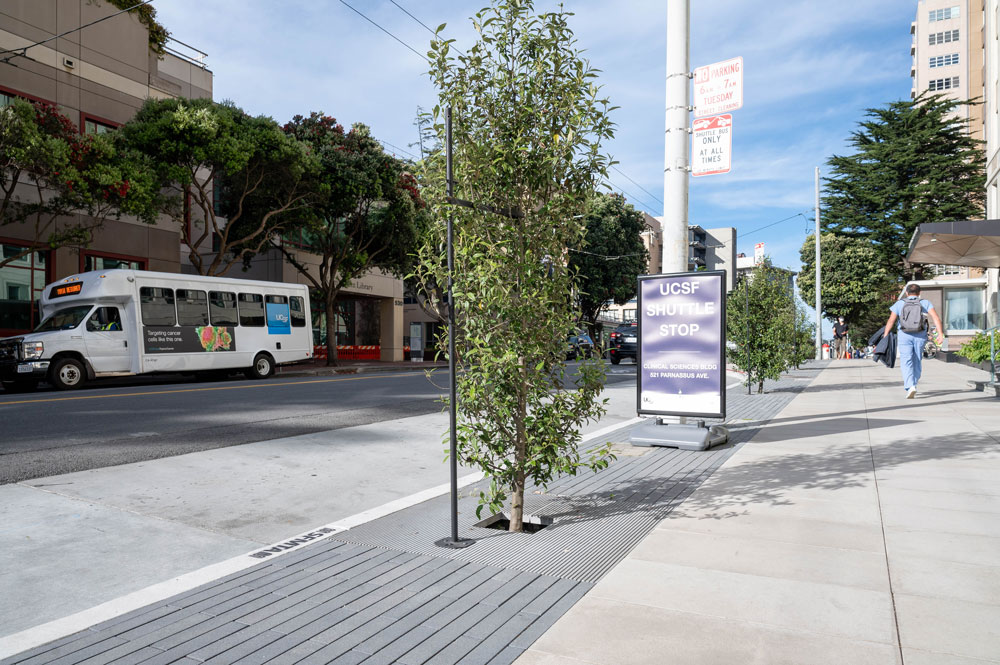UCSF Greening Project Will Link Park to Peak at Parnassus Heights
UC San Francisco is planning an extensive Parnassus Heights project that aims to green the campus with new landscaping, including planting more than 60 new trees along Parnassus Avenue and in the neighborhood.
This initiative comes as UCSF embarks on a 30-year plan to renovate the historic campus, building state-of-the-art research, education and health care facilities on the 107-acre site. Those plans include building the new hospital at UCSF Helen Diller Medical Center at Parnassus Heights, which is designed to meet the growing need for specialty care and is expected to open in 2030. The plans also gave UCSF the chance to reimagine how the campus fits into and welcomes the surrounding community.

Over the coming months and years, UCSF will plant trees, shrubs, grasses, and other plants around the hospital and in the surrounding community, guided by two principles.
The first is creating a “healing habitat,” a holistic design for the new hospital that incorporates natural light, plants and trees into the building’s architecture. The other is the concept known as “park to peak” – creating, via landscaping and expanded publicly accessible open spaces, a continuous greenway between Golden Gate Park and Mount Sutro.
“We have the opportunity to create a visual and pedestrian connection between Golden Gate Park, the campus, the neighborhood, and Mount Sutro,” says Ellie Rossiter, executive director for Community Relations & Strategic Partnerships.
Connecting Nature, Architecture and Community
Driving both the healing habitat and greening Parnassus Heights visions is an integrated landscape concept that strengthens the campus connection to the Mount Sutro Open Space Reserve.
UCSF has called Parnassus Heights, located at the foot of Mount Sutro, home since the 1890s and has served the City and San Franciscans in every public health emergency since then, from the 1906 earthquake to the COVID-19 pandemic. The transformation of UCSF’s oldest campus will continue that legacy with a closer connection to nature as a destination that welcomes neighbors.
We’re trying to make it easier for the internal UCSF community, patients and their families, and the surrounding neighborhood to access Mount Sutro.
The new hospital design includes landscaping that spills over the sixth-floor Sutro Terrace, as well as green oases on the 8th and 10th levels. The green streetscape extends the feeling of being immersed in nature into the surrounding neighborhoods.
“Park to peak is a visual connection, but also a literal connection,” says Joy Glasier, UCSF’s senior planner. “With more access points and greenery throughout campus, we’re trying to make it easier for the internal UCSF community, patients and their families, and the surrounding neighborhood to access Mount Sutro.”
Implicit in the “greening” of Parnassus Heights is using greenery that is tough enough for the fog, wind, and salt of that particular San Francisco microclimate. Hearty primrose trees will line the streets, while marina strawberry trees and Chinese elm will fill out the green space in front of the hospital.
Replacing Street Trees 2-for-1
The Parnassus Heights revitalization plan begins with two projects that bookend Parnassus Avenue – the new hospital and the future Parnassus Research and Academic Building. Together, those projects require the removal of 33 street trees. The Greening Parnassus Heights Project will replace each of these trees with two others – double the 1:1 ratio that the city requires.

Of these 66 trees, UCSF aims to plant 42 trees in the surrounding neighborhood within the next year, with another 24 trees along Parnassus Avenue later, as construction is completed.
“We want to invest in the community and neighborhood that we all live and work in, and recognize that there is an impact from the new hospital,” says Abby Ellis, UCSF director of Advocacy and Communications. “One of the ways to alleviate that impact is by planting more trees in the surrounding neighborhood.”
Calls for Community Input
UCSF has already started engaging the community in those plans. In early June, the University held the first community meeting to hear neighbors’ preferences on where to plant the first 42 street trees, starting with four options:
Option1
East from the hospital into Cole Valley
Option 2
West from the hospital into the
Inner Sunset
Option 3
Along five streets between Golden Gate Park and the hospital
Option 4
As a screen in front of a nearby parking garage
The University also distributed a survey of these options to residents, who have through the end of July to respond. In September, UCSF will release the survey results and will begin seeking a community-based tree-planting organization to conduct the work.
For questions and comments about greening Parnassus Heights, contact Abby Ellis at [email protected].
